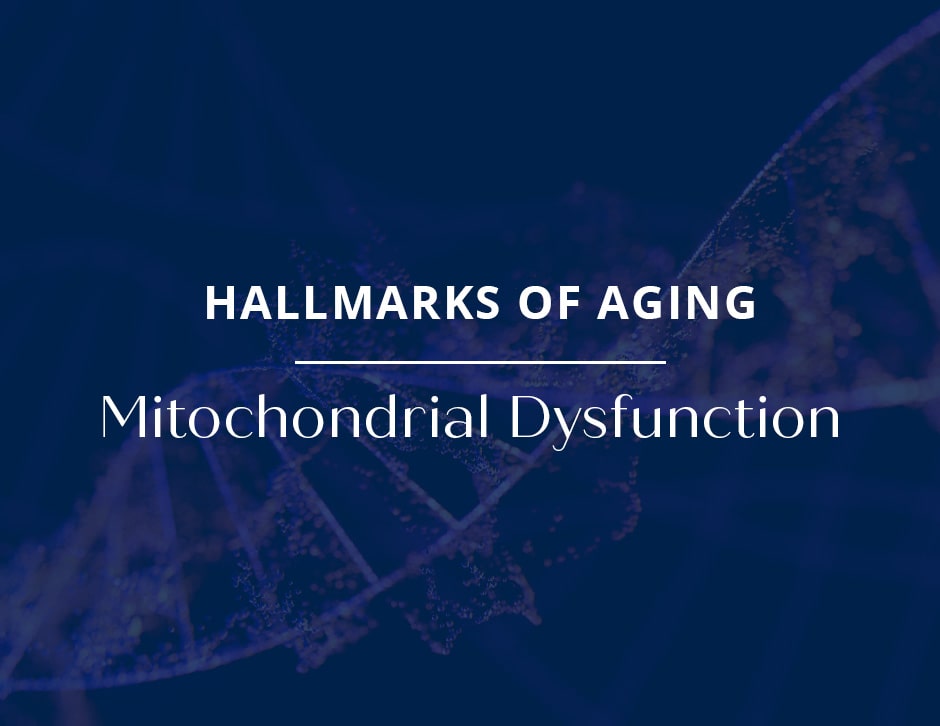
Quick overview of what you’ll learn from this blog post:
- What mitochondrial dysfunction is
- Why it happens
- The consequences of mitochondrial dysfunction
The Hallmarks of Aging describes mitochondrial dysfunction as the decline of the mitochondria and their ability to produce energy for the cell.
The powerhouses of the cell
The mitochondria are frequently referred to as the powerhouses of the cell. They act by turning the food we eat into a form of universal cellular energy currency called adenosine triphosphate (ATP). Our cells use ATP to fuel the many different cellular processes they perform from producing proteins, dividing to make new cells, repairing or recycling cellular components, and their many interactions with other cells.
Without the mitochondria to power our cells life would be impossible. These miniature energy factories are highly efficient but unfortunately, as we age, they start to deteriorate and things break down.
What causes mitochondrial dysfunction?
- Reactive oxygen species
- Decline of mitophagy
- Loss of NAD+
Reactive oxygen species are made by our mitochondria as a byproduct of energy production, a bit like how smoke and soot is a byproduct of burning coal or wood for energy. Reactive Oxygen Species describes a number of reactive molecules and free radicals derived from molecular oxygen.
Normally this is not a problem as the amounts produced are relatively low and manageable due to our cells having a number of ways to neutralize it. However, like many situations, things start going wrong as we age and the amount of reactive oxygen species produced rises significantly and our cellular defenses become less effective.
Unfortunately, most of the mitochondrial DNA is not protected in the cell nucleus like our own DNA is which leaves it more vulnerable to damage. Reactive oxygen species produced by the mitochondria bounce around the inside of the cell and can strike the mitochondrial DNA which can cause a mutation.
Another problem is that mitochondrial DNA repair is not as efficient as regular DNA repair is too which means damage is more serious. Over a period of time these mutations can build up causing a decline of energy production, the loss of energy production, risk of cancer, and can also harm proteostasis.
Decline of mitophagy is another contributing factor in mitochondrial dysfunction. Our cells have a variety of quality control and repair systems but as we age, these begin to break down.
When we are young the quality of mitochondria is maintained by a process known as mitophagy, the selective degradation of mitochondria by autophagy. This normally happens to defective mitochondria following damage or stress allowing them to be disposed of and replaced.
As we get older mitophagy becomes increasingly less effective allowing damaged and inefficient mitochondria to evade destruction. Initially this is not a problem as the cell contains thousands of mitochondria, so even a hundred or so being mutated is not a huge issue.
The problem comes when the mitochondria have mutations that give them an improved survival rate compared to healthy mitochondria. Over time this leads to the mutated mitochondria outcompeting the healthy ones until the cell is filled with inefficient and dysfunctional mitochondria.
Loss of NAD+ is also thought to be an important factor in mitochondrial dysfunction. Nicotinamide adenine dinucleotide (NAD+) is a coenzyme central to metabolism found in all living cells. NAD+ is involved in thousands of cellular functions including facilitating the production of ATP.
As we age NAD+ levels are believed to decline or are consumed more rapidly leading to shortages. So, while our ability to create NAD+ does not decline, the consumption of that limited pool increases. This then leads to a breakdown in the communication between the cell nucleus and the mitochondria which further diminishes ATP production and an increase in reactive oxygen species.
What can we do about mitochondrial dysfunction?
Researchers are working on ways to solve the problem of mitochondrial dysfunction and there is also some evidence that fasting might help clear out damaged mitochondria.
- Boosting NAD+ availability or production with supplementation methods
- Reducing the level of inflammaging
- Transferring the mitochondrial DNA to the cell nucleus
- Replacing dysfunctional mitochondria
- Inducing mitophagy (a sub division of autophagy) via drugs or fasting
If scientists can find ways to keep our mitochondria protected and healthy, it could help slow down how fast we age and protect us from a variety of age-related diseases.
